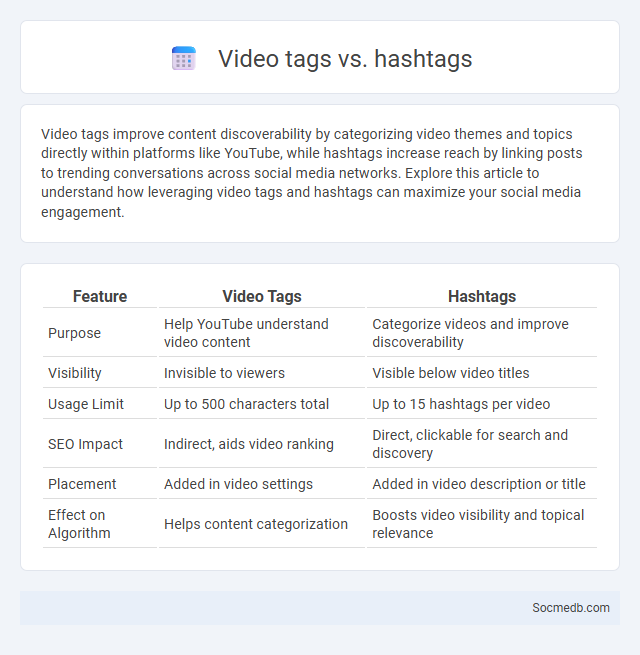
Photo illustration: video tags vs hashtags
Video tags improve content discoverability by categorizing video themes and topics directly within platforms like YouTube, while hashtags increase reach by linking posts to trending conversations across social media networks. Explore this article to understand how leveraging video tags and hashtags can maximize your social media engagement.
Table of Comparison
| Feature | Video Tags | Hashtags |
|---|---|---|
| Purpose | Help YouTube understand video content | Categorize videos and improve discoverability |
| Visibility | Invisible to viewers | Visible below video titles |
| Usage Limit | Up to 500 characters total | Up to 15 hashtags per video |
| SEO Impact | Indirect, aids video ranking | Direct, clickable for search and discovery |
| Placement | Added in video settings | Added in video description or title |
| Effect on Algorithm | Helps content categorization | Boosts video visibility and topical relevance |
Introduction to Video Tags, Hashtags, and Metadata
Video tags, hashtags, and metadata are essential tools that enhance the visibility and reach of your social media content by categorizing and describing your videos accurately. Using relevant video tags and hashtags helps platforms like Instagram, TikTok, and YouTube connect your content to trending topics and user interests, boosting engagement and discoverability. Optimized metadata, including titles, descriptions, and timestamps, improves search engine rankings and makes it easier for viewers to find your videos quickly.
What Are Video Tags?
Video tags are descriptive keywords added to video content, enhancing searchability and categorization on social media platforms like YouTube, Instagram, and TikTok. These tags help algorithms understand the video's subject, making it easier for users to discover relevant content based on their interests and search queries. Effective video tagging increases engagement by improving visibility in recommended videos, trending sections, and topic-specific feeds.
Understanding Hashtags in Video Content
Hashtags in video content significantly boost your visibility by categorizing videos within relevant topics and trends, helping target audiences discover your posts more easily. Effective use of popular and niche hashtags increases engagement rates and extends reach across platforms like Instagram, TikTok, and YouTube. Understanding hashtag analytics empowers you to refine content strategy and maximize your video's impact in a crowded social media landscape.
The Role of Metadata in Video Optimization
Metadata plays a crucial role in video optimization on social media by enhancing searchability and improving content discoverability through detailed tags, descriptions, and timestamps. Properly structured metadata allows algorithms to categorize videos accurately, boosting engagement rates and increasing visibility in user feeds. Leveraging metadata effectively supports targeted audience reach and positions content for higher ranking in platform-specific search results.
Key Differences: Tags vs Hashtags vs Metadata
Tags are keywords or labels assigned to content to categorize and organize posts within social media platforms, enhancing discoverability. Hashtags are special types of tags preceded by the "#" symbol, designed to aggregate and track conversations or trends across various platforms in real-time. Metadata includes broader information about the content such as author, date, location, and file type, providing context for search engines and improving SEO beyond user-generated tags and hashtags.
Impact on Search Engine Visibility
Social media significantly enhances search engine visibility by driving increased website traffic and improving content discoverability. High engagement on platforms like Facebook, Twitter, and LinkedIn generates valuable backlinks and social signals that contribute to higher search engine rankings. Consistent sharing of optimized content across social channels boosts brand authority, directly influencing organic search performance.
Platform-Specific Usage: YouTube, Instagram, TikTok
YouTube serves as a powerful platform for long-form video content, ideal for tutorials, reviews, and in-depth storytelling that can engage Your audience deeply. Instagram excels at visual storytelling through photos, Stories, and Reels, making it perfect for lifestyle branding and quick, impactful updates. TikTok's algorithm favors short, creative videos that can quickly go viral, offering unparalleled reach for trends, challenges, and authentic user engagement.
Best Practices for Using Video Tags, Hashtags, and Metadata
Optimizing video tags, hashtags, and metadata on social media enhances content discoverability and engagement rates. Accurate and relevant tags aligned with trending keywords improve search rankings and attract targeted audiences. Strategic hashtag use, combined with detailed metadata such as descriptions and timestamps, boosts visibility across platforms like Instagram, TikTok, and YouTube, driving organic growth and viewer retention.
Common Mistakes to Avoid
Common mistakes to avoid on social media include posting inconsistent content, neglecting audience engagement, and overlooking the importance of analytics. You should maintain a consistent posting schedule to build trust and use data insights to refine your strategy. Ignoring negative feedback or failing to respond can damage your brand's reputation and growth potential.
Conclusion: Selecting the Right Strategy
Choosing the right social media strategy is crucial for maximizing your brand's online presence and engagement. Tailoring content to fit platform-specific audiences and leveraging data analytics ensures higher reach and conversion rates. Your success depends on continuous optimization based on performance metrics and audience feedback.
 socmedb.com
socmedb.com